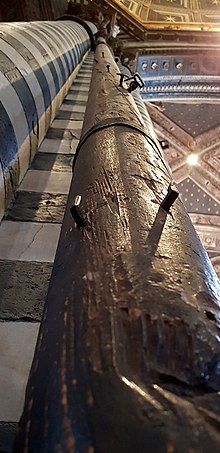
Back سارية علم Arabic Bayraq dirəyi Azerbaijani Флагщок Bulgarian Žerď Czech Fahnenmast German Asta (bandera) Spanish Lipumast Estonian Lipputanko Finnish Plus grands drapeaux du monde French תורן HE

A flagpole, flagmast, flagstaff, or staff is a pole designed to support a flag. If it is taller than can be easily reached to raise the flag, a cord is used, looping around a pulley at the top of the pole with the ends tied at the bottom. The flag is fixed to one lower end of the cord, and is then raised by pulling on the other end. The cord is then tightened and tied to the pole at the bottom. The pole is usually topped by a flat plate or ball called a "truck" (originally meant to keep a wooden pole from splitting) or a finial in a more complex shape. Very high flagpoles may require more complex support structures than a simple pole, such as a guyed mast.
Dwajasthambam are flagpoles commonly found at the entrances of South Indian Hindu temples.[1]
- ^ Hiltebeitel, Alf (1991). The Cult of Draupadi, Volume 2: On Hindu Ritual and the Goddess. University of Chicago Press. ISBN 0226340473. pp. 91–92.
© MMXXIII Rich X Search. We shall prevail. All rights reserved. Rich X Search